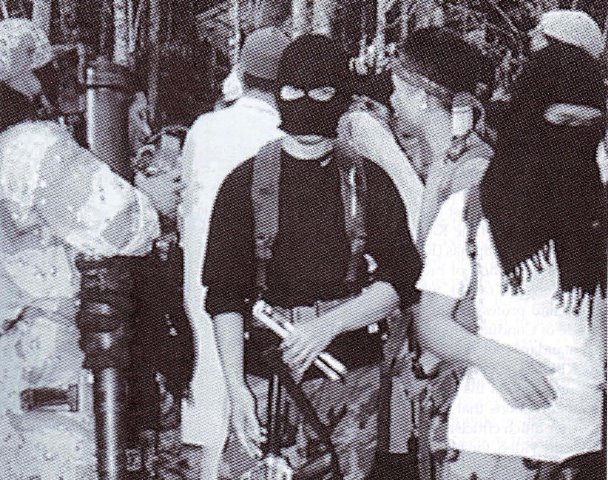Ideology and Ransom: The Abu Sayyaf and Rebel Groups

Photo by Charlie Saceda. Published in the Philippine Journalism Review Vol. XII No. 2 April 2002
“ARE THEY willing to talk or do we just fight it out?”
President Rodrigo Duterte, who was sworn into office Thursday, June 30, said this before his supporters in Cebu on June 25. The question came after Filipina Marites Flor was released by the Abu Sayyaf Group (ASG) on June 24. Along with Canadians John Ridsdel and Robert Hall, Flor was abducted by the ASG on the island resort of Samal, Davao del Norte in September 2015.
The question implied that the Duterte administration is considering peace talks with the ASG and sees the group as “connected with the issue of Mindanao.” The media did report on this angle but only superficially. In light of the resumed peace talks with the National Democratic Front of the Philippines (NDFP), the press failed to provide a clear differentiation between ideologically motivated groups like the Communist Party of the Philippines (CPP)-New People’s Army (NPA)-NDFP, the Moro Islamic Liberation Front (MILF), the Moro National Liberation Front (MNLF) and criminal groups such as the ASG.
Information Gap
Reports following Duterte’s question-statement lacked the necessary context needed for the public which would be correct in wondering how there can be peace talks between the government and a group that kidnaps and then beheads people for not paying ransom to understand the difference. No sufficient background information was given about the ASG. Neither was there any discussion about how peace talks work either.
Only a CNN Philippines report tried to fill the information gap by citing the bandit organization’s history. It recalled how the ASG began as a breakaway group of the MNLF, the areas in which it operates, its known leaders and how it began as a separatist movement calling for an independent Islamic state in Mindanao and evolved into a kidnap-for-ransom group. The report included some examples of the attacks and crimes committed by the ASG. (“Who are the Abu Sayyaf?” CNN Philippines, June 24, 2016)
Peace Pact with Terrorists?
As early as 1997, the U.S. State Department had tagged the ASG as a foreign terrorist organization. The Australian National Security Agency likewise listed the ASG as a terrorist group in 2002. It was also listed as associated with Al Qaeda and Jemaah Islamiyah by the United Nations Security Council in 2001. But that categorization, made more than a decade ago, may no longer apply to the ASG, since even a terrorist group has a political agenda.
Would the organization even be interested in peace talks should it be offered to them? The ASG is a different case in itself. At present, it operates as an organization profiting from criminal activities, mainly through kidnap-for-ransom, which is a far cry from its beginnings as a group espousing a separatist ideology.
Revolutionary movements like the MILF, the MNLF and the CPP-NPA-NDFP have clear demands driven by socio-political-economic ideologies. Peace talks between such groups and the government are necessarily based on negotiations over which of those demands both parties can accept.
One example is the signing of the Framework Agreement on the Bangsamoro (FAB) and the Comprehensive Agreement on the Bangsamoro (CAB) in 2012 and 2014, respectively, by the Government of the Philippines (GPH) and the MILF. The agreements laid out the mechanisms for the transition that would lead to the creation of the Bangsamoro entity through the Bangsamoro Basic Law (BBL), which the Aquino administration failed to pass during its term, unfortunately.
The Abu Sayyaf, on the other hand, may have begun with a belief in Moro autonomy and sovereignty. But it has since been driven by kidnapping for ransom, with no anchor on any ideology. Even its being tagged as a terrorist organization may be inaccurate, since terrorist organizations, despite their often indiscriminate use of violence, do have political and ideological aims.
By not differentiating revolutionary movements engaged in peace talks with the government from criminal groups like the ASG in their reports, the media are unwittingly encouraging the public to lump together as one and the same parties and groups that are very different. It is important to clearly distinguish the bandit groups from revolutionary organizations, most especially now since the Duterte administration is keen on resuming and continuing peace negotiations with the latter.
Leave a Reply